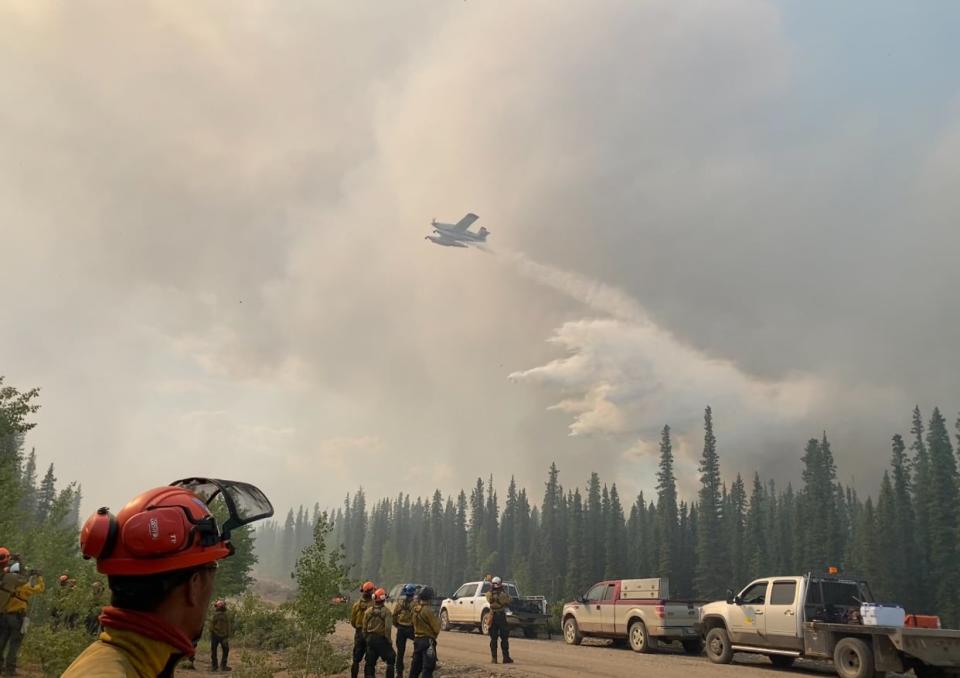TSB says parts failure responsible for fatal helicopter crash in Fort Good Hope, N.W.T.
The Transportation Safety Board of Canada says a parts failure is what caused a fatal helicopter crash last Friday near the Fort Good Hope, N.W.T., airport.
But how and why that part failed is yet to be determined.
The part is a tension torsion strap, a device that holds the majority of the rotor blade onto the main rotor head and is supported by two pins said Jon Lee, the western regional manager of the Transportation Safety Board of Canada (TSB).
"We didn't know how or why it broke, but that was the reason for the blade separating from the rotor head," he said.
Lee said a pilot — identified by Great Slave Helicopters on Tuesday as Tom Frith — took off at about 1:30 p.m. on June 28 in a Bell 212 to do forest fire suppression work. Shortly after takeoff, said Lee, one of the main rotor blades separated from the rotor head, and then the rotor head itself fell off.
The helicopter then collided with the ground and resulted in a post-impact fire.
Lee said the strap and some other parts have been recovered and are at a lab in Ottawa. A detailed examination is expected to take place next week.
"We'll hopefully get a bit better of an understanding as to the how and the why that strap failed," Lee said.
The manufacturer of the part that broke has been contacted, Lee said, and it is up to individual operators to decide whether to ground their fleets that have that part or to replace them.

Other organizations initially grounded similar helicopters
After the broken strap was recovered, Lee said his organization had learned many operators had voluntarily grounded various Bell helicopters out of precaution.
One of those operators was the B.C. wildfire service.
"Given the nature of the incident as it was initially reported, there was reasonable cause for caution until more facts were known," wrote Jaedon Cooke, a B.C. fire information officer.

Lee said the TSB then communicated that it was the tension torsion strap failure with various organizations, including Transport Canada and the Helicopter Association of Canada, who could then inform operators.
"These types of helicopters are used for forest fire suppression. And there was a great concern of, you know, those types of activities being curtailed because of the concern about what caused this rotor blade to separate," Lee said.
Trevor Mitchell, president and CEO of the Helicopter Association of Canada, gave credit to the TSB for providing the information so quickly.
"They were very proactive in getting this information out so that air operators could make very definitive and educated decisions related to their fleet if it were affected," he said.
Exactly 3 years since similar fatal crash
The incident bears some resemblance to another crash that happened three years to the day. A Bell 212 helicopter involved in wildfire suppression in Alberta crashed on June 28, 2021, killing the aircraft's pilot.
In that case the issue also involved the tension torsion strap, but it was one of the pins holding it together that failed instead.

John Cox, an aviation safety consultant and CEO of Safety Operating Systems, said although it's the same type of helicopter that crashed — it has likely more to do with what the Bell 212's are used for than the helicopters themselves.
"It's utilized in firefighting for example because it can hold quite a lot of water," Cox said.
Cox said firefighting is a challenging environment to fly in which is why accidents can happen there, but Bell 212s are proven to be successful in that task.
"You're dealing with a very dynamic environment, subject to a lot of change, both in temperature, wind direction, there are other aircraft in the vicinity," he said.
"But the fact that firefighting crews have been successful with the 212 indicate that this is a good machine for that application."


